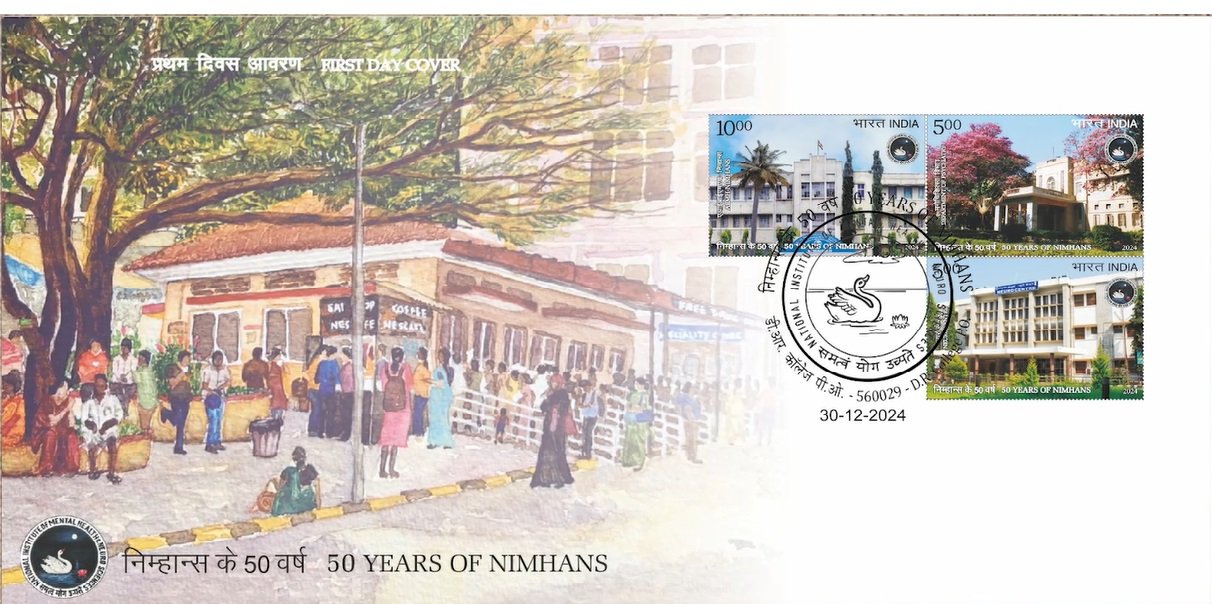50 Years of NIMHANS

Technical Data
| Stamp Set | 50 Years of NIMHANS |
|---|---|
| Date of Issue | December 11, 2024 |
| Denomination | Rs. 20 |
| Quantity | 211,000 |
| Perforation | Harrow14½ |
| Printer | Security Printing Press, Hyderabad |
| Printing Process | Wet Offset |
| Watermark | No Watermark |
| Colors | Multicolor |
| Credit (Designed By) | Mr. Suresh Kumar |
| Catalog Codes |
Stanley Gibbons IN MS3936 Colnect codes IN 2024.12.30-04 |
| Themes | Buildings | Healthcare | Hospitals |
The National Institute of Mental Health and Neuro Sciences (NIMHANS), Bengaluru, is a globally renowned institution in the fields of mental health and neurosciences. NIMHANS traces its origins to the Bangalore Lunatic Asylum, established in 1847. Over time, the asylum evolved and was renamed the Mysore State Mental Hospital in 1925, reflecting a shift in the management of mental illnesses in India. In the early 20th century, this hospital, along with the Ranchi-based institution, was one of only two purpose-built asylums in British India, designed to offer a healing environment with modern attributes.
A key turning point in NIMHANS’ development came in 1954 when the Government of India sanctioned the establishment of the All India Institute of Mental Health (AIIMH), based on recommendations from the Mental Health Advisory Committee and the Bhore Committee. The merger of the Mental Hospital and AIIMH in 1974 led to the creation of NIMHANS, integrating mental health and neurosciences under one roof. The Institute has since surpassed its initial role as a tertiary care centre, attracting patients from across India and neighbouring countries.
NIMHANS spans 135 acres and serves more than half a million patients annually. It offers state-of-the-art inpatient facilities and advanced rehabilitation services, with over 20 specialized clinics tailored to various conditions. The 1000-bed NABH-accredited hospital provides a comprehensive range of diagnostic and laboratory services, round-the-clock emergency care, and neurosurgical units. The seven-floor Sub-Speciality Block, equipped with sophisticated operation theatres, addresses complex neurological and neurosurgical problems.
The Institute’s research initiatives are extensive, spanning areas such as addiction, Alzheimer’s disease, brain imaging, deep brain stimulation, head injury treatment, and pain management. Active collaborations with regional, national, and international agencies ensure NIMHANS remains at the forefront of medical research. The research extends across multiple disciplines, including molecular genetics, rehabilitation, youth mental health, and yoga, contributing significantly to advancements in mental health and neurosciences.
As a leading postgraduate training centre, NIMHANS offers over 90 specialized courses, including MCh, DM, MD, postdoctoral fellowships, MPhil, MSc, and diploma programs. These attract students from across India and abroad, making NIMHANS a global hub for education in mental health. Beyond education, the Institute works closely with healthcare practitioners and policymakers to improve patient outcomes and enhance the broader healthcare system.
NIMHANS has also played a crucial role in shaping national mental health policy, contributing to the formulation of the National Mental Health Policy and advocating for rights-based mental health care. The Bellary model of care, developed by NIMHANS, was adopted as the basis for India’s District Mental Health Programme. As the nodal centre for the Tele MANAS program, NIMHANS is at the forefront of innovative mental health service delivery, expanding access to care across the country.
The Institute’s remarkable growth has earned it the status of ‘Deemed University’ in 1994 and ‘Institute of National Importance’ in 2012. It was the first Institute of National Importance in India to receive accreditation from the National Accreditation Board for Hospitals and Healthcare Providers (NABH), setting a benchmark for quality healthcare. NIMHANS consistently ranks among the top healthcare institutions in India, reflecting its commitment to excellence in patient care, research, and education.
First Day Cover

